Science, the world’s leading science magazine, publish on your front page an innovative French-Chilean research that rethinks the way we understand the reproduction of seaweed.
Just as a hummingbird carries pollen grains on its feathers, or a bee on its legs, in the same way certain crustaceans could participate in the process of reproducing algae in the sea. The male gametes of red algae do not have their own mobility and it has always been suggested that they depend entirely on transport by water currents to reach the females.
That until now, since a study published this week on the cover of Science, the world’s leading scientific journal, which brought together researchers from the Franco-Chilean International Research Laboratory “Evolutionary Biology and Ecology of Algae (EBEA)” of the Biological Station Roscoff (IRL 3614, CNRS, Sorbonne University, Catholic University of Santiago, Austral University of Chile), shows that the presence of a small isopod crustacean Idotea balthica favors the reproduction of the red algae Gracilaria gracilis.
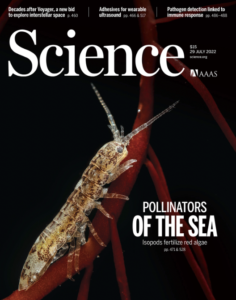
Cover of Science magazine highlights French-Chilean research that rethinks our understanding of the reproduction of seaweed.
The professor at the Austral University of Chile, Dr. Marie-Laure Guillemin, co-author of the study, explains that “this is the first time that this type of interaction between animals and algae has been described, which opens many questions about its ecology. and evolution. For example, this discovery suggests an older origin of animal pollination, which could have evolved before plants reached land,” she emphasizes.
Mutualistic interactions between plants and animals during pollination are widespread in the terrestrial environment. They are known to influence the reproductive process of 90% of angiosperms (flowering plants), the remaining 10% being essentially wind-pollinated. “In the marine environment -explains Dr. Guillemin-, it is generally accepted that fertilization occurs only through the movement of water. Therefore, the role of animals in the transport of male gametes was previously considered non-existent in red algae”.
How did they prove it?
To demonstrate this phenomenon, the researchers carried out a series of experiments in the laboratory to test the effect of the crustacean Idotea balthica on the fertilization of the Gracilaria gracilis algae. These two species are often found associated in rock pools in the English Channel, Europe. At low tide, in calm waters, these crustaceans move from algae to algae and feed on the biofilm and other plants that develop on their surface (epiphytes). When the tide rises, to resist the waves, they cling tightly to the algae with the sharp hooks on their legs.
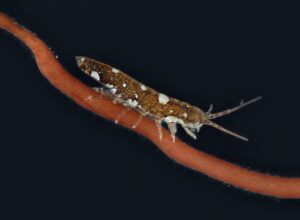
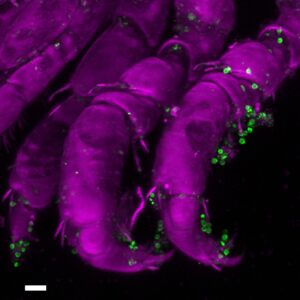
The small crustacean Idotea balthica facilitates the dispersal and fertilization of male gametes in the red alga Gracilaria gracilis. They use the bushy, densely branching red algae as shelter and feed on the microalgae that grow on their surface. In the left image, a specimen of the crustacean Idotea balthica can be seen climbing a stem of the red algae Gracilaria gracilis (male). It is at this time that the gametes of the algae adhere to the legs and body of the animal. In the image to the right, a
Confocal microscope image illustrating the presence of Gracilaria gracilis alga spermatia (green dots) on the body of a young specimen of the crustacean Idotea balthica.
“Performing these experiments turned out to be a daunting task,” says Emma Lavaut, a doctoral student at Sorbonne University, with tutors in France and Chile. However, the hard work paid off as the results clearly showed that the presence of this crustacean favors fertilization in the algae, “not only indirectly through its swimming activity and gill respiration, but also directly by transporting sperm (video) stuck to their body from the males to the females, which we were even able to record on video », maintain Emma Lavaut and Myriam Valero.
The researchers also detailed that the confocal microscopy analysis, carried out by Sebastien Colin, confirmed the presence of a large number of male gametes in the legs and abdomen of the crustaceans, that is, in the parts of the body that are in contact with the algae surface (photos, video). With this we demonstrate experimentally that the reproductive success of the algae is considerably increased. This would be done in particular during low tide “when the algae remain submerged in calm water”, they specified. (microscopy photo)
ocean protection
The scientists of the study maintain that at a time when marine environments are under strong anthropogenic pressure, these findings demonstrate the importance of preserving not only the species within ecosystems, but also the interactions between species. This study is in line with the UN Sustainable Development Goals 13 and 14 (SDG, Agenda 2030).







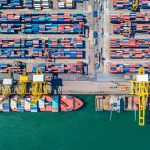
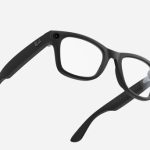

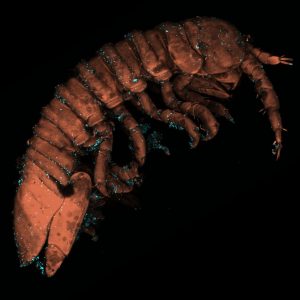
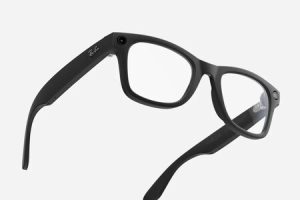
Add Comment